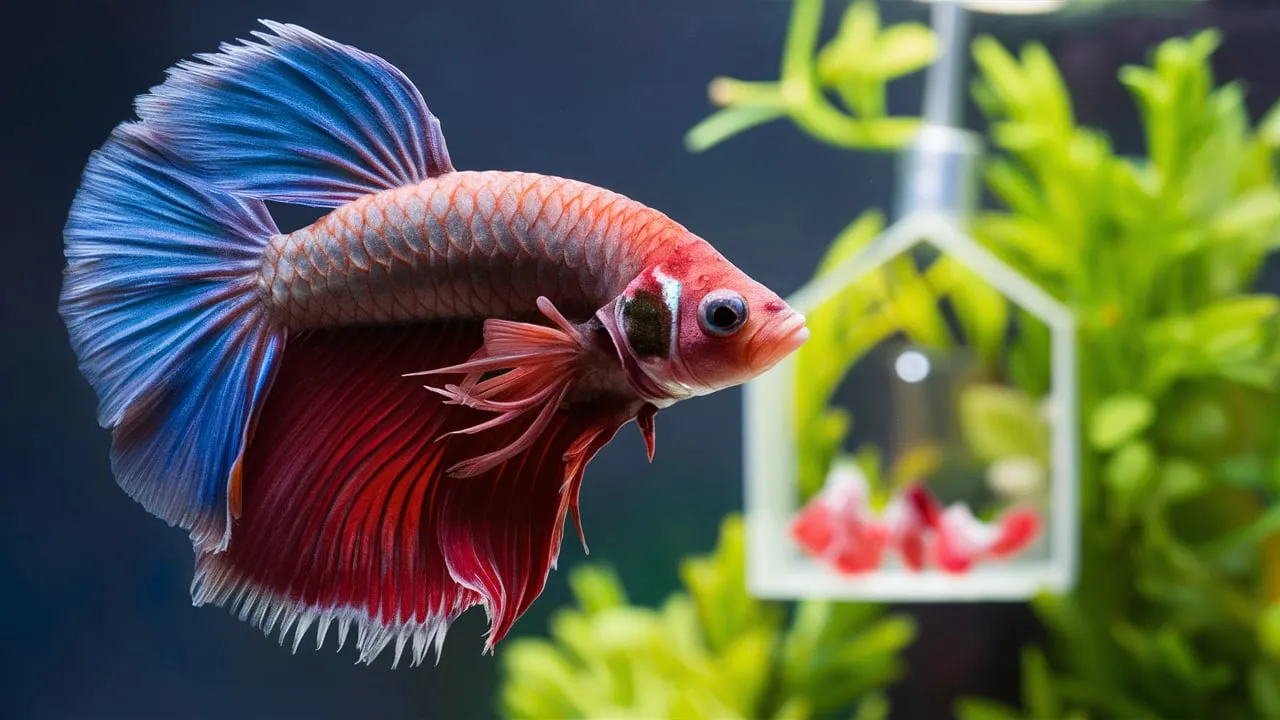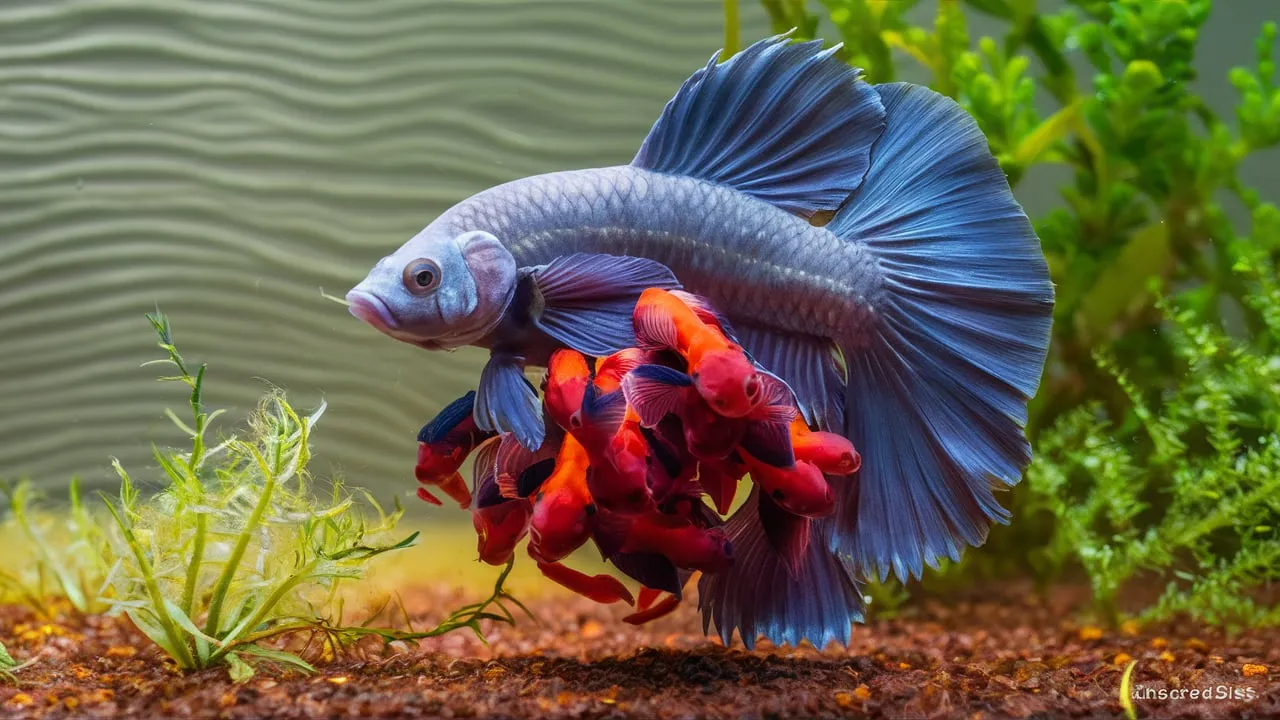Pregnant Betta Fish Giving Birth is a fascinating topic for both novice and experienced aquarists. If you are curious about this process, you’ve come to the right place!
In this Betta Fish Guide, we will explore everything you need to know about betta fish reproduction, including signs of pregnancy, the birthing process, and care for the fry.
Understanding Betta Fish Pregnancy
Signs of Pregnancy in Female Bettas
Identifying a pregnant betta fish is crucial for providing optimal care during this delicate period. Here are the key indicators that a female betta is carrying eggs:
- Swollen Abdomen: The most prominent sign of pregnancy is a noticeably rounder and larger abdomen, almost resembling a small, round ball.
- Darkening of the Abdomen: The color of the abdomen may darken, becoming more pronounced and often taking on a reddish or purplish hue.
- Increased Appetite: A pregnant female betta will likely exhibit an increased appetite as she needs extra nutrients to support the growing eggs.
- Restlessness: She may become more restless and agitated, moving around the tank frequently, especially as the birth approaches.
- Laying Eggs: While not a sign of pregnancy itself, if you observe the female laying eggs, it confirms she is pregnant and has likely been carrying the eggs for some time.
Differences between Egg-Carrying and Bloating
It’s important to distinguish between a pregnant female betta and one that is simply bloated. While both conditions can cause a swollen abdomen, there are key differences:
- Bloating: Bloating is often caused by overfeeding, poor water quality, or internal parasites. It can be accompanied by lethargy, loss of appetite, and changes in behavior.
- Pregnancy: A pregnant female will exhibit increased appetite, restlessness, and a darkening of the abdomen, along with a distinct roundness to her belly.
If you are unsure whether your female betta is pregnant or bloated, it’s best to consult with a qualified aquarist or veterinarian for diagnosis and treatment.
The Role of Male Bettas in Reproduction
Male bettas play a crucial role in the breeding process beyond simply fertilizing the eggs. They are actively involved in the care and protection of the developing fry:
- Bubble Nest Construction: The male betta builds a bubble nest, which is a vital structure for the survival of the fry. The nest is made of air bubbles that are carefully woven together and secured to a surface in the tank.
- Fry Protection: The male betta will fiercely defend the bubble nest and the fry within it from predators, including the female betta. He will often gather the fry in his mouth and gently deposit them back into the nest if they stray too far.
- Fry Care: The male betta will also help to keep the fry clean and ensure they have access to the surface for air. He may even guide them to the surface to breathe if they are struggling.
The male betta’s dedication to his offspring is a testament to the complex and fascinating world of betta fish reproduction.

Preparing for Betta Fish Birth
Ideal Tank Conditions for Pregnant Bettas
To ensure a safe and successful birthing process, it’s crucial to create the ideal tank environment for a pregnant betta:
- Tank Size: A 10-gallon tank is recommended for a breeding pair, providing ample space for the female to move freely and the male to build a bubble nest.
- Water Parameters: Maintain stable water parameters with a temperature of 78-82°F (25-28°C), a pH of 6.5-7.5, and low levels of ammonia, nitrite, and nitrates.
- Filtration: Use a filter that provides adequate water circulation without creating strong currents that could disrupt the bubble nest.
- Plant Cover: Include dense plant cover for the fry to hide in and seek protection from the female betta.
Essential Equipment for Birthing and Fry Care
Having the right equipment is essential for successful breeding and fry care:
- Heater: Maintain a stable water temperature for optimal breeding conditions.
- Filter: Provide adequate water circulation and filtration to maintain water quality.
- Thermometer: Monitor water temperature to ensure it remains within the ideal range.
- Breeding Box: A breeding box can be used to separate the female betta from the male after spawning, preventing her from eating the fry.
- Fry Food: Infusoria and other microscopic organisms are essential for feeding newborn fry.
Dietary Requirements for Pregnant Bettas
A pregnant female betta requires a nutritious diet to support her own health and the development of the eggs:
- High-Quality Betta Food: Offer a high-quality betta food that is rich in protein and essential nutrients.
- Live Foods: Supplement the diet with live foods such as bloodworms, brine shrimp, and mosquito larvae.
- Frequent Feedings: Feed the female betta several small meals a day to ensure she gets enough nutrients.

Caring for Betta Fry
Creating a Safe Environment for Newborn Fry
The fry are extremely vulnerable in their early stages and require a safe and nurturing environment:
- Fry Tank: A separate tank with a sponge filter and a heater is ideal for raising fry.
- Water Parameters: Maintain stable water parameters similar to those in the breeding tank.
- Plant Cover: Provide dense plant cover for the fry to hide and seek protection.
Feeding Schedules and Appropriate Foods
Feeding newborn fry is critical for their survival and growth:
- Infusoria: Infusoria are microscopic organisms that are essential for feeding newborn fry.
- Microworms: Microworms are another excellent food source for growing fry.
- Frequent Feedings: Feed the fry several small meals a day to ensure they get enough nutrients.
Monitoring Fry Growth and Development
Monitor the fry’s growth and development closely:
- Growth Rate: Healthy fry should grow rapidly and exhibit a healthy appetite.
- Appearance: Observe their appearance for any signs of illness or deformities.
- Water Changes: Perform regular water changes to maintain water quality and prevent disease.
Conclusion
Breeding betta fish can be a rewarding experience, but it requires careful planning, preparation, and attention to detail. By understanding the intricacies of betta fish pregnancy, the birthing process, and the essential care required for both the mother and her fry, you can create a nurturing environment for successful breeding and the joy of raising a new generation of these captivating creatures.

Related Posts
Culture Of Infusoria In The Tank: A Microscopic Feast for Fry
Almond Leaf For Betta: A Natural Habitat Enhancer
Clamped Fins On Betta: Causes & Treatment